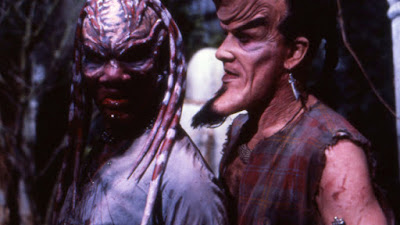PHENOMENALITY: *marvelous*
MYTHICITY: *fair*
FRYEAN MYTHOS: *drama*
CAMPBELLIAN FUNCTIONS: *metaphysical*
I remember being mildly entertained by the original 1990 release of Clive Barker’s NIGHTBREED, though I don’t believe I ever re-watched it. Thus, I wasn’t able to note specific changes upon screening the director’s cut on the SHUDDER streaming service. Reputedly this version adds back forty minutes of unused footage, and from an antiquarian standpoint I’m glad the fuller version exists. All I can say, then, is that the longer running time didn’t harm the pace of the movie, in contrast to the way various added scenes detracted from the pace of Milos Forman’s AMADEUS. But if the added scenes don’t hurt NIGHTBREED’s pace, they also don’t make any difference to the movie’s greatest fault: its underdeveloped characters.
The movie’s script closely follows the plot (such as it is) of Barker’s 1988 novel CABAL, reviewed here. Human tumbleweed Aaron Boone (Craig Sheffer)—whose means of self-support is no more evident here than in the novel—bounces around between a big city in Alberta and a ghost town in the boonies, beneath which a group of shapeshifting monsters have constructed their own subterranean city, Midian. Evil psychiatrist Decker (David Cronenberg) is also a part-time serial killer, and even though no one suspects him in the least, he decides for some vague reason to frame Boone for his crimes. Boone escapes durance vile, and both Decker and Boone’s girlfriend Lori (Anne Bobby) pursue him to Midian. Lori shows her devotion to Boone by braving the underground city of monsters, who have inadvertently made Boone into one of them when one monster, Peloquin by name, tries to take a bite out of the young fugitive. Decker, though still obsessed with Boone, transfers his animus in part to Midian, calling up the local law to root out the monstrous denizens, leading to a destructive battle between “norms” and “freaks.” In the end Midian is destroyed, but Boone, under the name Cabal, becomes the new Moses for the shapeshifters, though Barker never got around to chronicling further adventures of the Midianites. The film was not a success and garnered no sequels, unless one counts Marvel’s NIGHTBREED comic book.
Many horror-mavens love the idea of “monster mashes,” which are usually convocations of creatures with separate origins and natures. Barker’s city of monsters, despite having different forms, share the same origins, much like the polymorphic weirdos in the two WAXWORK films. Barker implies that the Nightbreed started as deceased human beings who simply turn into shapeshifters rather than rotting in the earth like most mortals. But there’s no rhyme or reason to their culture, vaguely centered around the worship of a deity (or ancestor) named Baphomet. They’re forbidden to eat human flesh, even though some or all of them would like to, which aligns their nature somewhat with both vampires and zombies. I imagine Barker avoided even minimal exposition because he had some notion that he was being more “poetic,” but the author’s idea of poetry is dull and forced. In the book Barker does a poor job of making the Nightbreed visually interesting. He may or may not have played a role in designing the monsters for the film, so the film’s improvement on creature-visuals may owe something to his efforts. However, I tend to credit the excellent work of the film’s makeup department, which gave substance to vaguely described book-characters like Peloquin. However, the makeup people couldn’t do anything to make the characters better. Alejandro Jodorowsky called NIGHTBREED the ”first gay horror film,” and in tune with this statement, Barker shows a marked tendency to champion the shadowy denizens of his demimonde as “good” (aside from occasional cannibalism) while all the “norms,” the “straights,” are assholes. This trope can be done well, as seen in Tod Browning’s FREAKS. But because all of Barker’s characters are flat and bereft of history, NIGHTBREED never “breeds” any sympathy for the devils.
On a purely kinetic level, Barker’s direction proves far better than his successful 1987 HELLRAISER, which was so cheaply made that it was practically a chamber-play on film. The big battle-scene is much more pleasingly gross than anything in the book, and the book’s dull climactic fight between Boone and Decker becomes here a more bracing Hollywood-style brawl with good back-and-forth violence. The three principals handle their tasks quite well, with solid work from Sheffer, Bobby and even Cronenberg, best known for his work behind the horror-camera. The various players in monster-makeup also acquit themselves well; they’re just not given anything interesting to do. (One forgettable “character moment” includes Peloquin and Lori debating as to which of them has prior claim on Boone’s body and soul.) Barker may have had an exaggerated idea of his film’s chance for sequels, since both versions of NIGHTBREED conclude, unlike the book, in the villain’s resurrection, presumably to continue his jeremiad against the monster-folk. Given how poorly most of the HELLRAISER sequels turned out, the done-in-one nature of NIGHTBREED is probably all to the best.

This comment has been removed by the author.
ReplyDeleteOh, yeah, if I was unclear about that, I admire the first two Hellraiser films more than Nightbreed. I was just endeavoring to point out that Hellraiser looks like it was made conservatively in terms of budget, while Barker had a much higher budget on Nightbreed.
ReplyDeleteHaving done all this Barker research, and since I did like Jihad, I'm looking at the possibility of reviewing the Marvel Nightbreed series.